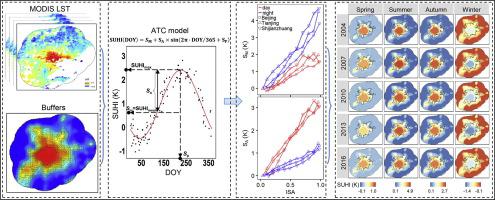Geoscience Frontiers ( IF 8.9 ) Pub Date : 2021-01-10 , DOI: 10.1016/j.gsf.2021.101141 Huidong Li , Yuyu Zhou , Gensuo Jia , Kaiguang Zhao , Jinwei Dong

|
Urban heat island (UHI), driving by urbanization, plays an important role in urban sustainability under climate change. However, the quantification of UHI's response to urbanization is still challenging due to the lack of robust and continuous temperature and urbanization datasets and reliable quantification methods. This study proposed a framework to quantify the response of surface UHI (SUHI) to urban expansion using the annual temperate cycle model. We built a continuous annual SUHI series at the buffer level from 2003 to 2018 in the Jing-Jin-Ji region of China using MODIS land surface temperature and imperviousness derived from Landsat. We then investigated the spatiotemporal dynamic of SUHI under urban expansion and examined the underlying mechanism. Spatially, the largest SUHI interannual variations occurred in suburban areas compared to the urban center and rural areas. Temporally, the increase in SUHI under urban expansion was more significant in daytime compare to nighttime. We found that the seasonal variation of SUHI was largely affected by the seasonal variations of vegetation in rural areas and the interannual variation was mainly attributed to urban expansion in urban areas. Additionally, urban greening led to the decrease in summer daytime SHUI in central urban areas. These findings deepen the understanding of the long-term spatiotemporal dynamic of UHI and the quantitative relationship between UHI and urban expansion, providing a scientific basis for prediction and mitigation of UHI.



























 京公网安备 11010802027423号
京公网安备 11010802027423号